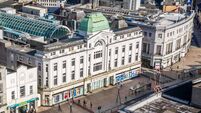Following the footsteps of Moses
THE CHILDREN of Israel escaped to Sinai and the Egyptians perished “in the midst of the sea”. With all due respect to the book of Exodus, the Red Sea is exceedingly deep. It reaches 3,000 metres in places with a great ridge running down its centre. Only a fifth of it is less than 50 metres deep and underwater cliffs fall away sharply just out from the coast. The Israelites must have descended into a marine equivalent of the Grand Canyon.
Africa, moving steadily northwards, has smashed into Europe, pushing up the Alps and Pyrenees. The traffic jam of tectonic plates produced a long rift valley where the Red Sea is today. About 40 million years ago, a great crack appeared. The Arabian peninsula snapped open, like a door on a hinge (you can almost hear it creak as you look at the map) and the waters of the Indian Ocean flooded into the valley, just as the Bible says they did when Pharaoh’s army tried to make the fatal crossing. With no rivers flowing into it, the sea is unusually salty. Named after its red corals, this warm spur of the Indian Ocean has marine creatures of every sort, from dolphins to turtles. The only notable absentees are sea-snakes.
The exceptionally clear waters make the Red Sea a Mecca for divers. A thousand species of fish have been recorded, 17% of them being found nowhere else in the world. Hammerheads, and the infamous tiger shark, patrol where the reefs plunge to the depths. Snorkelling off Abu Ramada island last month, I saw no sharks but I did encounter a magnificent moray eel. Morays are mostly nocturnal, so I was lucky to come upon this two-metre giant swimming about during the day.
The eels have no connection with the Moray Firth; the name is Portuguese, derived originally from Latin. A murex was a shellfish from which a dye was extracted in Roman times. The name also denoted a sharp stone resembling the shellfish; a moray spends the daylight hours in a hole with its snout protruding like a pointed stone and this is probably how it got the name. The dorsal fin, waving gracefully as the eel swims, runs all the way down the back from behind the head. A moray has no pectoral fins, the fish equivalent of arms. This absence gives it a snake-like ghoulish appearance, which is not helped by its having to keep the huge mouth slightly open, in order to get enough oxygen. Despite their fearsome appearance, morays are harmless, unless you try to interact with them. It you do so, you may receive a nasty bite. This is one of the few fish known to hunt co-operatively with another species; some morays form coalitions with groupers.
It would be hard to find more contrasting realms than the one under the surface of the Red Sea and the landscape above it. The marine world teems with life, while the land appears arid and dead. The Red Sea is enclosed by desert, but not a romantic sandy one, à la Peter O’Toole in Lawrence of Arabia. The Eastern Desert resembles the surface of the Moon or a gigantic quarry of pulverised white stone, baking under a merciless sun. Temperatures reach 55C in high summer. There is life here but creatures such as snakes and scorpions emerge only after dark. A few dozen Bedouin families, their women veiled in black robes in the merciless sun, eke out a nomadic existence on this giant frying pan. How they manage to do so is incomprehensible to somebody from cool, damp Ireland.
The underwater wealth has spawned a huge tourist industry, centred on Hurghada on the western shore of the sea and Sharm el Sheikh at the tip of the Sinai Peninsula. The ancient Egyptians produced magnificent buildings. The Greeks and Romans borrowed from them; the classical buildings which adorn cities all over the world derive ultimately from Egyptian elements. Architecture, alas, is no longer Egypt’s strong point. Nor is physical planning, although coming from Ireland, I am reluctant to criticise; the pot may be calling the kettle black. A few decades ago, Hurghada was a tiny fishing village. Now it is a 24km long disorganised sprawl of apartments and bland hotels, each one jostling with its neighbours for access to a stretch of beach. Many buildings remain half-built, their roofless skeletons giving the place a bombed-out look; in Egypt, property owners become liable for tax only when a building has been completed.
But every cloud has a silver lining. The larger hotels have landscaped gardens, some of them beautifully maintained. The green lawns are dotted here and there with date palms and clumps of tamarisks. Despite their potty-trained artificiality, these gardens are of considerable environmental value, not just for tourists but for birds. Migrants from Europe and Asia, on their way to and from countries south of the Sahara, tend to follow the Red Sea coast. Prior to the building of the resorts, there would have been few ‘rest and recreation’ centres along the route at which exhausted little birds could take a break. Now the sprinklers in the grounds of the hotels provide oases of green with plenty of water in which birds can bathe and drink.













